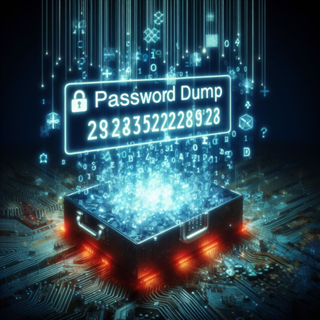What Is Password Dumping?
Password dumping is a technique used by attackers to obtain passwords stored on a system or network. This typically involves extracting password hashes or plaintext passwords from memory, files, or databases on compromised systems. Once obtained, these passwords can be used by attackers to gain unauthorized access to accounts, systems, or networks.

Here's how password dumping typically works:
- Accessing System Resources: Attackers gain unauthorized access to a system or network through various means such as exploiting vulnerabilities, using malware, or leveraging social engineering techniques.
- Dumping Passwords: Once inside the system, attackers use specialized tools or techniques to extract passwords from different sources. This could involve dumping password hashes from the Windows SAM (Security Account Manager) database, extracting plaintext passwords from memory, or accessing password files stored on the system.
- Cracking Passwords: After obtaining the password hashes or plaintext passwords, attackers may attempt to crack them using password-cracking tools or techniques. This involves trying different combinations of characters until the correct password is found.
- Unauthorized Access: With the cracked passwords, attackers can gain unauthorized access to accounts, systems, or networks. This can lead to data theft, system compromise, or further exploitation of the target environment.
Falling victim to a password dumping attack can have severe consequences for individuals, organizations, and even entire networks. Some of the key consequences include:
- Unauthorized Access: Attackers can use the stolen passwords to gain unauthorized access to accounts, systems, or networks. This can lead to the compromise of sensitive data, financial loss, or disruption of critical services.
- Data Theft: Once inside a system or network, attackers can exfiltrate sensitive data such as personal information, financial records, intellectual property, or trade secrets. This can result in identity theft, fraud, or reputational damage for individuals and organizations.
- Account Takeover: With access to user accounts, attackers can impersonate legitimate users to carry out further malicious activities, such as sending spam, spreading malware, or launching additional attacks from within the compromised environment.
- Privilege Escalation: In some cases, attackers may be able to escalate their privileges within the system or network, gaining access to additional resources, sensitive information, or administrative controls. This can exacerbate the impact of the attack and make it more difficult to contain and mitigate.
- Financial Loss: Password dumping attacks can result in financial losses for organizations due to theft of funds, fraudulent transactions, regulatory fines, legal fees, and the costs associated with incident response, remediation, and recovery efforts.
- Reputational Damage: A data breach resulting from a password dumping attack can tarnish the reputation of an organization, eroding trust among customers, partners, and stakeholders. This can have long-term consequences for brand loyalty, customer retention, and market competitiveness.
- Compliance Violations: Depending on the industry and regulatory requirements, falling victim to a password dumping attack may lead to compliance violations and penalties. Organizations may be subject to fines, legal action, and mandatory data breach notifications to affected individuals and regulatory authorities.
Overall, the consequences of a password dumping attack can be wide-ranging and severe, highlighting the importance of robust cybersecurity measures to prevent, detect, and respond to such incidents effectively. To prevent password dumping and mitigate the associated risks, here are some best practices:
- Use Strong Passwords: Encourage users to create strong, complex passwords that are difficult to guess or crack. This includes using a combination of uppercase and lowercase letters, numbers, and special characters.
- Implement Multi-Factor Authentication (MFA): Enforce multi-factor authentication wherever possible. MFA adds an extra layer of security by requiring users to provide additional verification, such as a one-time code sent to their mobile device, in addition to their password.
- Regularly Update and Patch Systems: Keep systems, applications, and security software up to date with the latest patches and updates to minimize the risk of exploitation through known vulnerabilities.
- Monitor and Analyze System Logs: Regularly monitor system logs and network traffic for any suspicious activity that could indicate an attempted or successful password dump. Intrusion detection systems (IDS) and security information and event management (SIEM) solutions can help with this.
- Limit User Privileges: Follow the principle of least privilege by only granting users the permissions they need to perform their jobs. This reduces the potential impact of a successful password dump by limiting the attacker's access to sensitive resources.
- Encrypt Passwords: Store passwords securely using strong encryption algorithms. Hash passwords with salt to make them more resistant to cracking if they are obtained by attackers.
- Educate Users: Train users on cybersecurity best practices, such as avoiding phishing emails, using unique passwords for each account, and being cautious about sharing sensitive information online.
By implementing these measures, organizations can significantly reduce the risk of password dumping and enhance their overall cybersecurity posture. Keep in mind that compliance with best practices builds trust with customers and partners. Also, cost savings result from preventing data breaches and peace of mind comes from knowing that proactive measures safeguard accounts and sensitive information.


